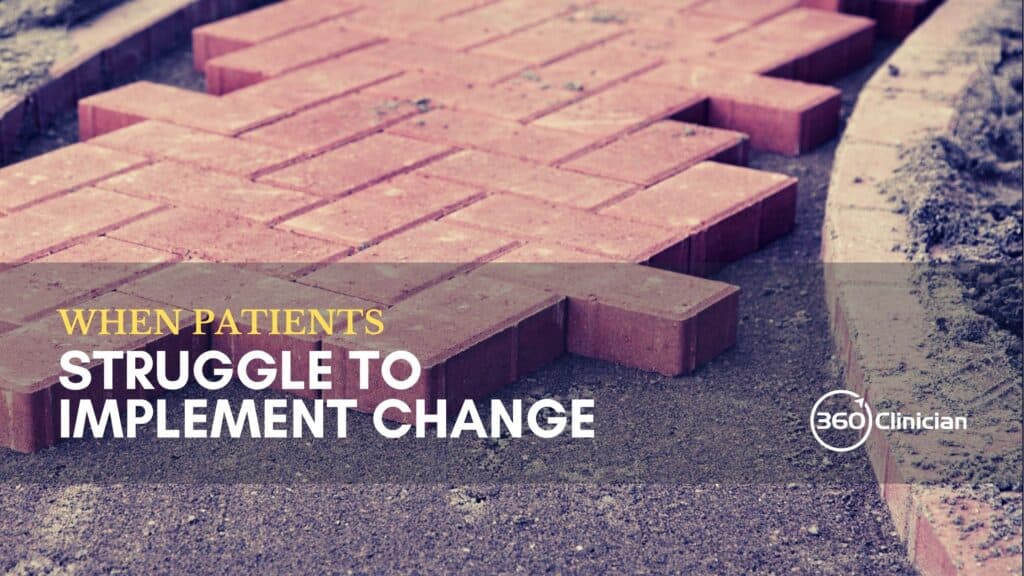Keeping our patients motivated can be hard.
Let’s face it. Their motivation ebbs and flows.
Helping our patients sustain their motivation is crucial to them achieving their goals.
Let’s look at the all too common scenario:
A patient is highly motivated when they come in because they’re in pain. As the pain decreases, their motivation starts to decrease. The problem that was all pressing to them weeks earlier has now become less urgent. They start to be more haphazard with their exercises. Maybe they’ve cancelled their sessions a few times.

Helping our patients stay motivated can be one of the most important arrows in your quiver to help our patient achieve their goals.
Today I want to show you how you can overcome this all-too-common problem we face in our clinical practice. I’m going to show you how you can use goal setting to help you tap into a deeper level of motivation that moves beyond decreasing pain.
Move Below the Surface
Often times goal setting can feel a little redundant during our history taking. We can anticipate what they’ll say. More often than not they want less pain.
But having less pain helps them do things that they’re avoiding right now. Understanding what they want to get back to helps to go a layer deeper, but there’s more. Got it. We think of goal setting as something that we can know if we’ve achieved our patient’s objectives. Which is very important. But I think it can be a lot more – it can help us unlock the motivation levers for our patients.
But before I dive in, let me share a story that hit home for me.

This summer, there was one particular July day that was hot and sunny. Towards 7pm I got the idea it would be great to get in a little paddle boarding before the sun went down. I pictured myself getting out on the lake, laying on the board with the sun beaming on my face.
I knew I didn’t have much time, but I wanted to get to the lake as quickly as possible. As I was driving there, the shadows made me feel worried; there wasn’t much daylight left.
When I got to the parking lot, I pumped up my paddle board as quickly as possible and hustled to the beach. Within a few minutes of being on the lake, I finally laid down on my board. The sun warming me as I lay on the board. I had achieved the mental picture that had propelled me just 30 minutes earlier. I experienced what I desired – an emotion of peace and rest.
Even though I was running against the clock and faced enough opportunities to pack it in, I was struck with the staying power I experienced. My desire and the associated mental picture of laying on the board with the sun shining on my face was more than enough to keep me motivated to the end.
Emotion Drives Action
While we believe that sound rational reasons are what motivates people, we have to remember that emotion drives action. Behavioural researcher BJ Fogg stresses that feeling drives behaviour and emotion is what creates habits.
Desire, which is emotion directed to a particular end state is a powerful motivator. Just think of car advertising. Even though we need a car to get from point A to point B, they don’t sell us on that. They focus on desire. They immerse us in an experience so we can picture ourselves in that vehicle and the associated desire it satisfies.
With our patients we need to understand what they will feel when they can do their desired activity. We need to explore this feeling and use it to help them succeed.
What I’ve put together is a simple three step process to harness the power of patient goal setting to elevate & sustain patient motivation for better outcomes.
Here are the three steps that will help you tap into accessing emotion & desire for your patients.
Step #1: Scratch the Surface
As simple as it is, ask them what their goals are for treatment. Give yourself some space and time to talk about goals with your patient. Start by simply asking them what their goals are. If the patient hesitates, I will often use the phrase “If i wave a magic wand, what would you want.”
Step #2: Understand the Why
The next step is to dig a little deeper. A useful connecting phrase is “so that“. Connect the stated goal of less pain, fewer symptoms, etc to something that they want to get back to. For example, I want to have less pain so that I can get back to playing badminton.
I ask my patients:
- What do you want to do again if you had less pain?
- What would less pain and movement allow you to do?
Step #3: Uncover the Underlying Desire
Once you understand what they want to get back to, you want to explore the underlying desire or emotion that they experience when they do that activity.
If for our patient, playing with their kids again is important, what do they feel when they play? Maybe it’s a feeling of connectedness or for the patient who wants to get back to the gym, maybe it’s a feeling of strength and wholeness.
For a recent patient of mine who was dealing with knee pain, she wanted to go up and down stairs without knee pain. For her the emotion she wanted to experience again was freedom of movement and youthfulness.

Last Thing
While goal setting may seem to be relegated to the initial exam session, it is an important piece that needs to be revisited throughout the care process as motivation wanes. When a patient experiences a significant drop in pain, it can be very helpful to revisit the patient’s goals and collaboratively identify the next mountain to climb together.
To better flow,
Andrew
If you enjoyed this article and want to stay up-to-date on my newest content, sign up for the Clinical Flow Newsletter! There you will have access to special offers, exclusive content, and be part of a growing community of clinicians with the purpose of improving yourself and your clinical practice.


